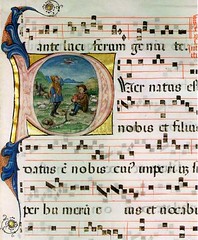Gregorian Chant is a good thing. Plainchant is another name for this kind of music. It is very old - at least 3000 years. Jewish Christians brought the music from the Jewish liturgy into the early church and it has been there ever since. Some tunes are found in both Jewish and Christian liturgies, though sung in a different style.
It was not written down until the eleventh century, when the four-line notation was invented by Guido d'Arrezo. Before that, the tune was indicated by little curved marks called neumes; these are similar to the cantillation marks found in Hebrew printed bibles. But because they do not indicate the actual pitch of the notes, the music had to be learned by heart, and there are sometimes slightly different versions of the same music as a result.
Musicologists have been comparing old manuscripts marked with these neumes, and it is now possible to gain a better idea of how the music was performed before the four-line square-note system was introduced. There is a book called the Graduale Triplex which includes both the four-line notation and the older neumes written in over the top of the music. If you follow both, it makes the music sound more lively and prevents it from becoming plodding and dirge-like, which is always a hazard with chant when you just look at the notes.
The four-line notation used for Gregorian Chant is easier to read than the modern five-line stave, and when chant is written in modern notation, important information about how to sing the music is lost.
It is not written in a key, but in one of eight Modes or moods, of which the modern major and minor keys are two of them. Some modes have a bright feel to them, others are sombre and reflective, so the music includes a wide range of "palettes" - colourations. Mostly, the music spans little more than an octave so is not too demanding on the singers, and a good choirmaster will adjust the overall pitch to stay within the range of his performers.
"Performers" is not the right word, though, because the music is prayer, not performance, and for this reason, "rehearsals" are live and better referred to as practice.
No special musical talent is needed to participate. The key elements are, in order of importance.
(1) Listening, because the music comes out of silence.
(2) Breathing
(3) Sounding
If a group of people follow these principles, they will make a lovely sound.
In the Western (Latin) tradition, the language of the chant has been Latin. Gregorian Chant music does not go well into English because the vowels are awkward and the stress points in English sentences are all wrong. But in these days of large-scale population movements, the need to achieve integration and increasing multi-national contacts, such is the EU and its institutions, the time for Latin has returned. You can even listen to the news in Latin on Finnish radio, as hardly anybody knows Finnish.
MUSIC YOU CAN DOWNLOAD
MORE MUSIC YOU CAN DOWNLOAD
HOW TO READ GREGORIAN CHANT
News in Latin (with a Finnish accent)
It was not written down until the eleventh century, when the four-line notation was invented by Guido d'Arrezo. Before that, the tune was indicated by little curved marks called neumes; these are similar to the cantillation marks found in Hebrew printed bibles. But because they do not indicate the actual pitch of the notes, the music had to be learned by heart, and there are sometimes slightly different versions of the same music as a result.
Musicologists have been comparing old manuscripts marked with these neumes, and it is now possible to gain a better idea of how the music was performed before the four-line square-note system was introduced. There is a book called the Graduale Triplex which includes both the four-line notation and the older neumes written in over the top of the music. If you follow both, it makes the music sound more lively and prevents it from becoming plodding and dirge-like, which is always a hazard with chant when you just look at the notes.
The four-line notation used for Gregorian Chant is easier to read than the modern five-line stave, and when chant is written in modern notation, important information about how to sing the music is lost.
It is not written in a key, but in one of eight Modes or moods, of which the modern major and minor keys are two of them. Some modes have a bright feel to them, others are sombre and reflective, so the music includes a wide range of "palettes" - colourations. Mostly, the music spans little more than an octave so is not too demanding on the singers, and a good choirmaster will adjust the overall pitch to stay within the range of his performers.
"Performers" is not the right word, though, because the music is prayer, not performance, and for this reason, "rehearsals" are live and better referred to as practice.
No special musical talent is needed to participate. The key elements are, in order of importance.
(1) Listening, because the music comes out of silence.
(2) Breathing
(3) Sounding
If a group of people follow these principles, they will make a lovely sound.
In the Western (Latin) tradition, the language of the chant has been Latin. Gregorian Chant music does not go well into English because the vowels are awkward and the stress points in English sentences are all wrong. But in these days of large-scale population movements, the need to achieve integration and increasing multi-national contacts, such is the EU and its institutions, the time for Latin has returned. You can even listen to the news in Latin on Finnish radio, as hardly anybody knows Finnish.
MUSIC YOU CAN DOWNLOAD
MORE MUSIC YOU CAN DOWNLOAD
HOW TO READ GREGORIAN CHANT
News in Latin (with a Finnish accent)

Kommentarer
Bruce Fletcher
Stronsay, Orkney